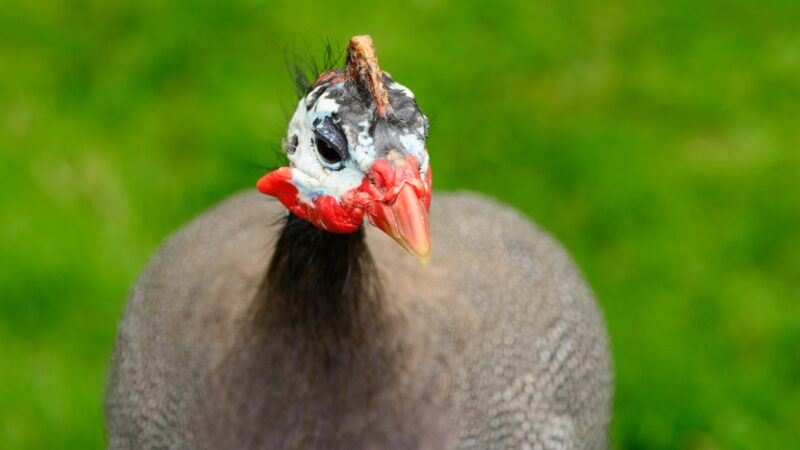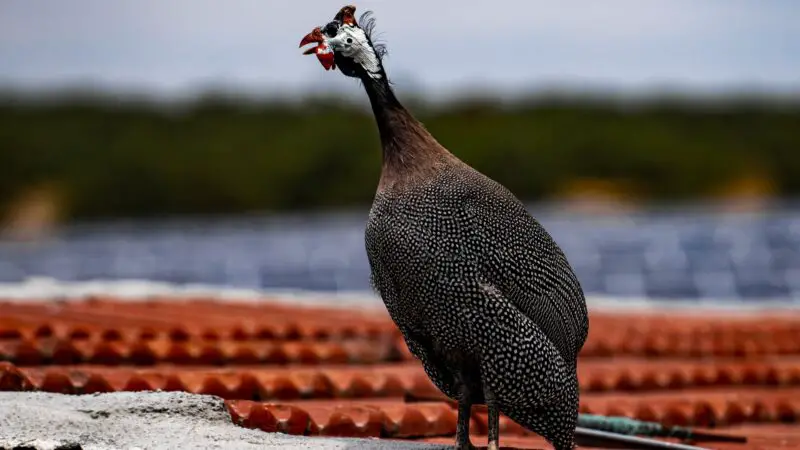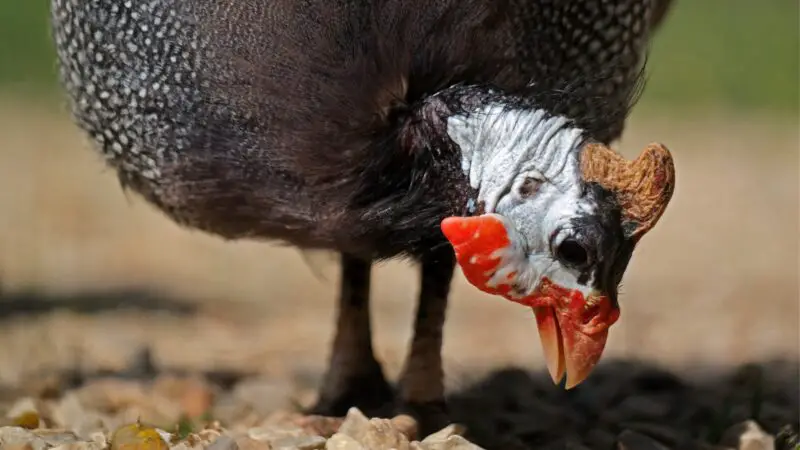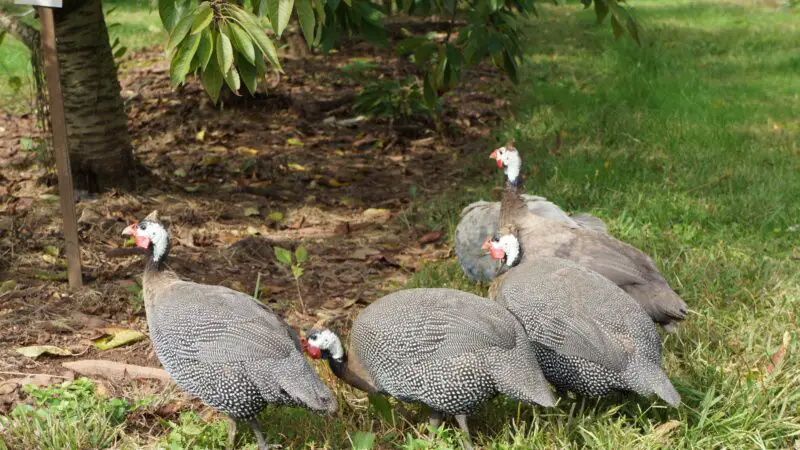If you hear some harsh and repetitive calls from a farm, they are most likely from guinea fowls. These bird sounds are irritating but are very useful to them and farmers. The presence of guinea fowls can be better than other methods of repelling insects and wildlife inside a property. This includes small but venomous snakes.
Guinea fowl may kill snakes that trespass on their territory. They are very protective creatures with great teamwork in attacking intruders, regardless of their size. Their aggressive personalities make them very excellent guard dogs on farms.
Male guinea fowls are called roosters, females are called hens, and babies are called keets. Regardless of gender and age, these noisy and alert birds can benefit farms.
But before deciding to raise them, you should better understand their characteristics and behavior. Keep on reading to discover more about guinea fowls.
Guinea Fowls Identification

Where Do Guinea Fowls Originate?
Guinea fowls originated in West Africa and are known to be the ancestors of the domestic stocks found on farms. Little is documented about the history of these birds, except that they belong to the Numididae family. The most common wild guinea fowl species is the helmeted guinea fowl, domesticated for centuries.
What Do Guinea Fowls Look Like?
Domesticated guinea fowls come in various color varieties, including Buff Dundotte, Chocolate, Coral Blue, Lavender, Pearl, and White. The last three colors are the most common in the US. These chicken-like fowls have vigorous, round bodies, brown eyes, and red or blue wattles. They also have short wings and tails and a hunched posture.
Guinea fowls somehow look like vultures since their small heads and long necks are featherless. Most roosters have bigger wattles pointing downwards as compared to hens. Some females may have no wattles, though. Both sexes have short, stout, and curvy beaks. Each foot has four clawed toes, and one toe faces the other way around.
What Are the Distinct Characteristics of a Guinea Fowl?
The most distinct characteristic of a Guinea fowl is its plumage, usually gray with white spots. Helmeted guinea fowls are also easily recognized for their unique bone-like structure on their heads. Even if you don’t see guinea fowls, you will know they are just nearby because of their annoying, loud noises, especially when disturbed.
How Big Do Guinea Fowls Grow?
Guinea fowls are medium-sized and may be as big as chickens but are noticeably longer. They can be between 16 to 28 inches (40.6 to 71.1 cm) long, with an average length of 20 inches.
Adults can grow about 2 feet tall and are shorter than the chicken’s average height of 2.5 feet. Their exact sizes vary, depending on the age and overall health of the bird.
Are Guinea Fowls Heavy Breed?
Guinea fowls are considered a heavy breed. Adult males weigh 3.3-3.5 lbs (1.5-1.6 kilos), and adult females are a bit heavier at 3.5-3.7 lbs (1.6-1.7 kilos).
But on average, most helmeted guinea fowls only weigh 2.8 lbs (1.3 kilos). At 70 days old, keets can already weigh 1.8-1.9 lbs (820-860 grams). Chickens are heavier than guinea fowls.
Guinea Fowl Wingspan
Helmeted guinea fowls have a wingspan of 59-71 inches (149.9-180.3 cm). Despite being heavyweight and having short wings, these birds are strong flyers and can even fly backward. However, they prefer running away rather than flying when in danger.
How Long Does a Guinea Fowl Live?

Helmeted guinea fowls have an average lifespan of 12 years. Some domesticated ones can live up to 13-15 years when properly cared for.
What Is Guinea Fowl Known For?
Guinea fowls are primarily raised for meat and egg production. Guinea fowl meat is known for being leaner, tastier, and easier to cook than chicken meat.
It is also popular in supermarkets, grocery stores, and restaurants across the US and the UK. Guinea fowl hens lay 100 brown-spotted eggs or more per year between April and October.
Other Benefits of Having Guinea Fowls

Helmeted guinea fowls are also hailed for being effective insect pest controllers. They eat crickets, flies, grasshoppers, lice, and wood ticks. A flock of these fierce insect eaters can also scare away wild animals such as foxes, opossums, rats, snakes, and wild birds by making a lot of noise. In short, guinea fowls are great watchdogs.
Are Guinea Fowls Aggressive?
Guinea fowls can be aggressive and are more hostile than chickens. Although they can be trained to be docile and friendly, these loud fowls, especially males, usually assert dominance. Guinea fowls may also attack turkeys, chickens, and other bigger animals. They are not cuddly birds and may attack humans, even their owners.
Do Guinea Fowls Bite?

Guinea fowl do bite humans and animals, too. These birds are very territorial and will also chase and kick any intruder. Males are very protective of their hens, and hens will also not hesitate to defend their young. So far, there are no reports on how painful guinea fowl bites are. But due to their aggressiveness, you should avoid getting bitten.
Do Guinea Fowls Deter Snakes?
Guinea fowl can deter snakes, especially the smaller ones. These birds are naturally social creatures and prefer being in a group rather than going solo. Therefore, if one sees a snake, it will alarm others by making a lot of noise. Males usually repeatedly make a one-syllable loud call, while females sound like a “buckwheat” call.
Do Guinea Fowls Chase Snakes?

Guinea fowls chase snakes that will enter their territory. If the snake does not leave after making some loud noises and the snake will not leave, it will approach the reptile and form a circle. These noisy birds will go around the predator until they are discouraged from fighting back and will go away. In 2015, a viral video showed guinea fowls chasing a small snake.
Do Guinea Fowls Eat Snakes?
Guinea fowls may eat snakes, but only those that will fit their beaks. These loud birds are omnivores, meaning they eat plants and animals. Therefore, it will not be a surprise if they can eat small snakes and rats. But in most cases, guinea fowls kill snakes to defend their territory, not to eat them. They prefer insects and plants.
Will Snakes Eat Guinea Fowl Eggs?
Snakes eat guinea fowl eggs and can swallow them whole. They will also eat adult guinea fowls and keets if given a chance.
As we all know, snakes attack chicken coops and eat live chickens, chicks, and chicken eggs. But as mentioned earlier, guinea fowls always work as a team and can easily scare small snakes away.
Related Questions
Will Guinea Fowl Kill Chickens?
Guinea fowls will also kill chickens since they are more aggressive. Despite being a bit smaller, these featherless head birds can bully roosters out of their pens or chase them away.
In some cases, guinea fowls may also protect chickens from predators by screaming a warning call. But in general, these two fowls don’t go well together in a coop.
Do Guinea Fowl Carry Diseases?
Some guinea fowl may carry diseases that can be transmitted to humans. Generally speaking, they are healthy and can be considered nearly disease-free. But guinea fowls are also prone to common poultry diseases like chickens, ducks, pheasants, and turkeys. To give an idea, here are some illnesses that guinea fowls can suffer from:
1. Bird Flu
Also known as Avian influenza, bird flu can be transmitted to humans through contact with droppings and saliva from infected birds. Some birds may not show symptoms of this illness but may decrease egg production. People who work very closely with birds are the most at risk. Wild birds are more prone to bird flu than domesticated ones.
2. Colibacillosis (E. Coli)
Commonly known as E. coli infection, Colibacillosis is caused by Escherichia coli. This infectious disease is one of the primary causes of mortality and morbidity in poultry. Some infected birds may look well despite having this illness, while others may show ruffled feathers and eat less. E. coli can spread to humans via unsanitary pens and equipment.
3. Salmonellosis
Salmonellosis is not only common to poultry but to other animals as well. Salmonella bacteria live in the intestines of animals and humans, and infected animals may look healthy and will not show symptoms. This bacterial infection can be transmitted to humans through consuming contaminated food or water and touching infected animals.
4. Newcastle disease
Newcastle disease (ND) is caused by a paramyxovirus that affects domestic poultry, including guinea fowls. This highly contagious respiratory disease is found worldwide, and the virus can be present in birds, dead or alive. Transmission to humans is mostly through direct contact with feces, contaminated food and water, and human clothing.
5. Campylobacteriosis
Campylobacteriosis is a poultry disease that can infect humans who eat undercooked meat and have touched bird poop or contaminated items. Most infected birds may not show symptoms, while infected persons can have diarrhea and fever. Although treatable, it can be serious to children, the elderly, and people with the weak immune systems.
Note: Some diseases are rare in humans or can only cause mild effects. And again, guinea fowls are known for having a high immune system. Nevertheless, you should always practice good hygiene and clean surroundings when handling birds. Purchase them only from reputable hatcheries and make sure they are vaccinated accordingly.
Are Guinea Fowls Worth It?
Guinea fowls are worth taking care of given the benefits they offer on farms. They also require low maintenance.
So far, the only factor that may make you think twice is their annoying sounds. Therefore, these birds can be a nuisance to neighbors, especially if you live in urbanized areas. But other than that, guinea fowls are a great addition to your farm.
